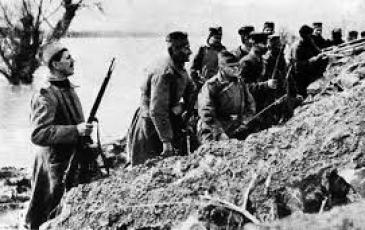1914_1117_01: From Victory to Defeat - FWWC 03 Serbia '14

 0 - 0 - 0
0 - 0 - 0

| Rating: | 0 (0) |
| Games Played: | 0 |
| SM: | 8 |
| Turns: | 230 |
| Type: | Stock |
| First Side: | Central Powers |
| Second Side: | Allied Powers |
Kolubara River, Serbia, 17th November 1914:
After the battle of Valjevo, the Serbians were in full retreat where they hastily took up positions about 30 km east, along the Kolubara and Ljig rivers. Both sides were exhausted after nearly two weeks of intense fighting and marching, supplies were low, and the Serbian Army was being bled white. For the Austro-Hungarians, victory seemed to be within their grasp but the commanders of the XV. and XVI.Korps from the 6.Armee pleaded with Potiorek for a full week to rest, replace losses and resupply.
Initially this request was granted and as XV. and XVI.Korps settled down to rest around Valjevo, Potiorek instructed that the 5.Armee should continue advancing to the Kolubara, and should exert pressure on the Serbian "rear guard" that was assumed to be covering the Serbian Army's retreat.
By the 19th it became obvious that 5.Armee and other elements of 6.Armee had encountered stiff resistance along the lower Kolubara, so Potiorek made a fateful decision: a full week could not be spared to the XV. and XVI.Korps because he felt the Serbian Army had been on the brink of collapse and he did not want to afford it time to recover and establish another strong defensive position where they had proven most tenacious. First the XV.Korps, then later the XVI.Korps were ordered to advance forward to help drive off the enemy's "rear guard".
As both Austro-Hungarian armies pushed forward in strength again, it quickly became obvious that the Serbian force was not a rear guard at all; the entire Serbian Army had taken up residence and had every intention of holding their position. By holding the Kolubara and Ljig for as long as possible, the Serbian Army intended to delay the Austro-Hungarians long enough that supplies from France and Russia would help turn the tide of battle. If need be, the Serbian Army would withdraw to the Arandjelovac area to make its last stand in either victory, or defeat. In reality the Serbian Army would come to the brink of collapse and then, against all odds, launch a vicious counter offensive in the subsequent Battle of Arandjelovac, that would end up completely expelling the Austro-Hungarians from Serbia for a second time.
[Size: large]
*See the notes document for information on scenario design decisions and historical notes.
After the battle of Valjevo, the Serbians were in full retreat where they hastily took up positions about 30 km east, along the Kolubara and Ljig rivers. Both sides were exhausted after nearly two weeks of intense fighting and marching, supplies were low, and the Serbian Army was being bled white. For the Austro-Hungarians, victory seemed to be within their grasp but the commanders of the XV. and XVI.Korps from the 6.Armee pleaded with Potiorek for a full week to rest, replace losses and resupply.
Initially this request was granted and as XV. and XVI.Korps settled down to rest around Valjevo, Potiorek instructed that the 5.Armee should continue advancing to the Kolubara, and should exert pressure on the Serbian "rear guard" that was assumed to be covering the Serbian Army's retreat.
By the 19th it became obvious that 5.Armee and other elements of 6.Armee had encountered stiff resistance along the lower Kolubara, so Potiorek made a fateful decision: a full week could not be spared to the XV. and XVI.Korps because he felt the Serbian Army had been on the brink of collapse and he did not want to afford it time to recover and establish another strong defensive position where they had proven most tenacious. First the XV.Korps, then later the XVI.Korps were ordered to advance forward to help drive off the enemy's "rear guard".
As both Austro-Hungarian armies pushed forward in strength again, it quickly became obvious that the Serbian force was not a rear guard at all; the entire Serbian Army had taken up residence and had every intention of holding their position. By holding the Kolubara and Ljig for as long as possible, the Serbian Army intended to delay the Austro-Hungarians long enough that supplies from France and Russia would help turn the tide of battle. If need be, the Serbian Army would withdraw to the Arandjelovac area to make its last stand in either victory, or defeat. In reality the Serbian Army would come to the brink of collapse and then, against all odds, launch a vicious counter offensive in the subsequent Battle of Arandjelovac, that would end up completely expelling the Austro-Hungarians from Serbia for a second time.
[Size: large]
*See the notes document for information on scenario design decisions and historical notes.





















